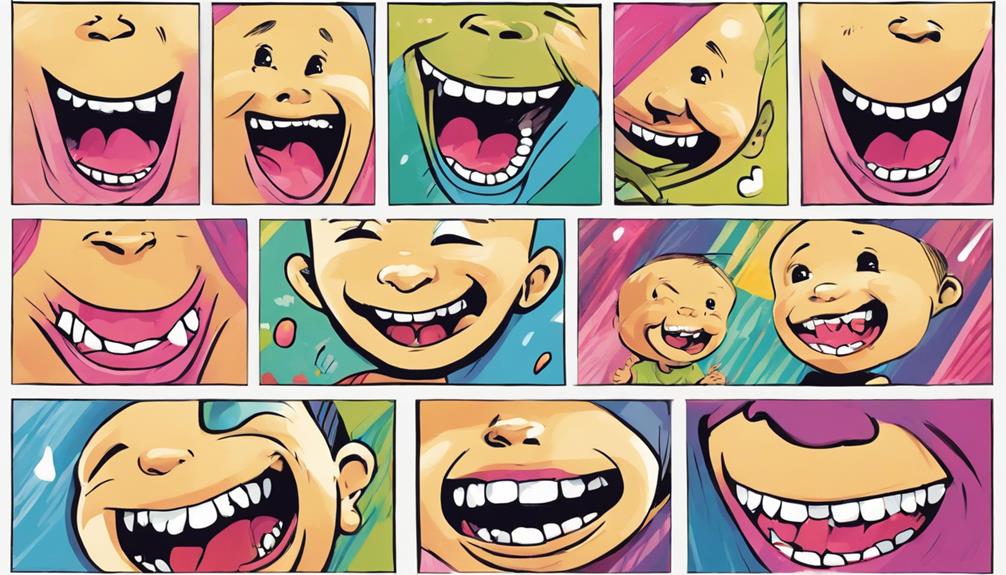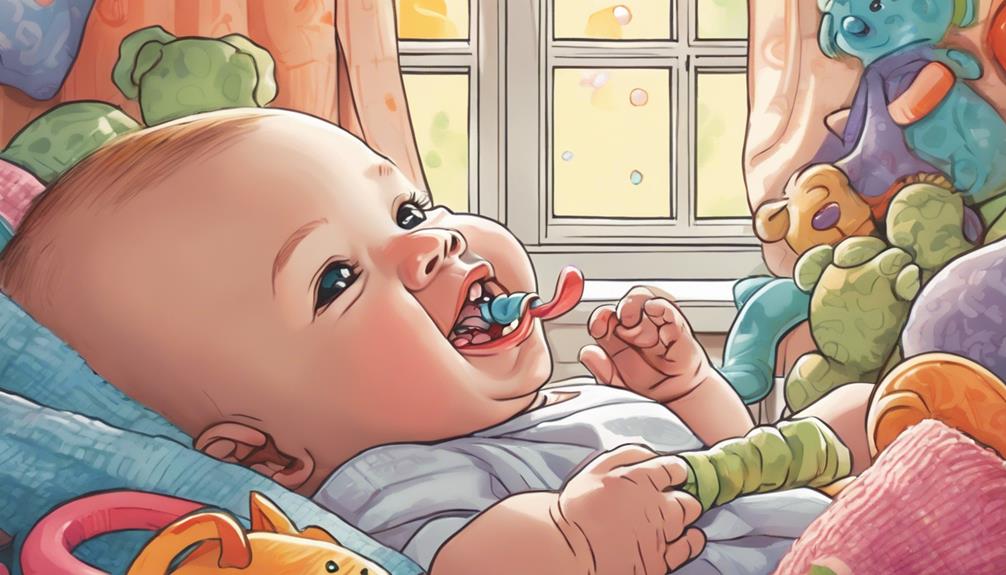Baby teeth usually come in a specific order. Expect the lower central incisors to erupt first between 6 to 10 months. Next, the upper central incisors appear from 8 to 12 months. After that, the upper lateral incisors come in between 9 to 13 months, followed by the lower lateral incisors at 10 to 16 months. First molars arrive next, with lower ones showing up between 14 to 18 months. Finally, the lower second molars appear between 23 to 31 months. Keep exploring to discover more about the teething process and how to ease any discomfort your baby might feel.
Key Takeaways
- Baby teeth typically erupt in a specific order, starting with lower central incisors around 6 to 10 months.
- Upper central incisors usually follow, emerging between 8 to 12 months.
- The upper lateral incisors come next, appearing between 9 to 13 months.
- Lower lateral incisors emerge after, typically between 10 to 16 months.
Overview of Baby Teeth Eruption

Have you ever wondered when your baby's first teeth will start to appear? The process of teething typically begins between 6 to 12 months, with primary teeth, or baby teeth, making their debut.
Usually, the lower central incisors are the first to erupt, coming in around 6 to 10 months. This initial eruption can be an exciting milestone, but it may also bring some discomfort for your little one.
Following the lower central incisors, you can expect the upper central incisors to emerge between 8 to 12 months.
As your baby continues through the teething phase, the upper lateral incisors will appear next, usually between 9 to 13 months, followed by the lower lateral incisors between 10 to 16 months.
The eruption of these teeth marks significant growth in your baby's mouth and can impact their eating and speaking abilities.
Sequence of Tooth Emergence

Understanding the sequence of tooth emergence helps you anticipate which teeth will come in next as your baby grows.
Typically, the first teeth to appear are the lower central incisors, emerging between 6 to 10 months. After those, you can expect the upper central incisors to come in, usually between 8 to 12 months.
Next in the order do baby teeth come are the upper lateral incisors, which usually erupt between 9 to 13 months, followed by the lower lateral incisors from 10 to 16 months.
The first molars typically make their entrance next, with upper first molars appearing between 13 to 19 months and lower first molars between 14 to 18 months.
Timeline of Teething Stages
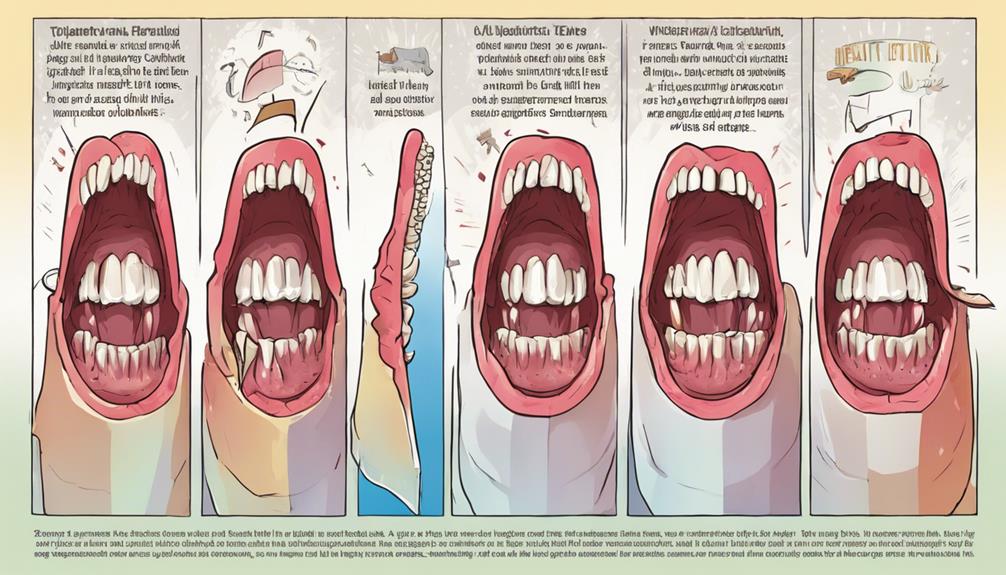
Teething stages unfold in a predictable timeline, helping you track when your baby's teeth are likely to emerge. By knowing this timeline, you can better prepare with teething rings and other soothing options as your little one experiences discomfort.
Here's a breakdown of the typical teething stages:
| Age Range (Months) | Teeth Erupted | Type of Teeth |
|---|---|---|
| 6 – 10 | Lower Central Incisors | Primary Incisors |
| 8 – 12 | Upper Central Incisors | Primary Incisors |
| 13 – 19 | Upper First Molars | Primary Molars |
| 23 – 31 | Lower Second Molars | Primary Molars |
Teething Symptoms and Signs
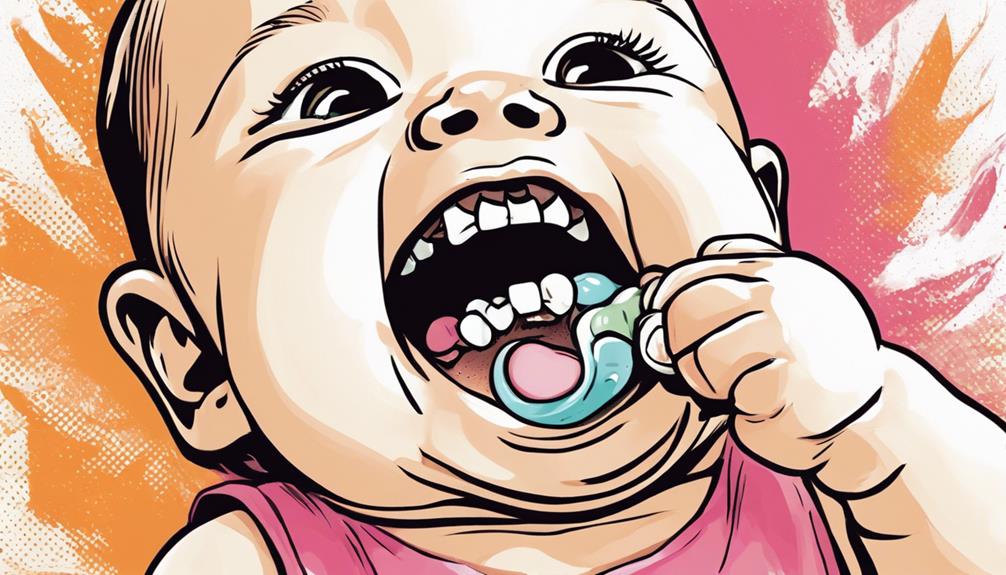
When your baby starts teething, you'll notice a variety of symptoms that can include irritability, drooling, and swollen gums.
You might also see them gnawing on objects to ease their discomfort.
Understanding these signs helps you find effective soothing techniques to make this stage easier for both of you.
Common Teething Symptoms
Many parents notice common teething symptoms like irritability, excessive drooling, and swollen gums as their baby's teeth begin to come in. These signs of discomfort can start appearing about a month before the first teeth break through, with sore and red gums being a clear indicator.
You might see your baby's cheeks flushed, a sign that they're feeling the pressure of teething. Increased fussiness and disrupted sleep patterns often accompany this phase, making it a challenging time for both of you.
As your baby is teething, they may also exhibit a strong desire to gnaw on objects, which helps relieve the pressure of the erupting teeth. While it's common for infants to develop a low-grade fever during this time, remember that a true fever isn't typically associated with teething.
Keep an eye on these symptoms, as they can guide you in understanding what your little one is experiencing. Recognizing the signs of discomfort will help you support your baby during this important developmental milestone. With patience and care, this phase will pass, paving the way for those adorable first teeth to shine through!
Soothing Techniques for Discomfort
Soothing your baby's sore gums can make a world of difference during this discomforting phase. Teething can be tough, but you've got some effective techniques to help ease the discomfort. Consider the following options:
| Technique | Description | Benefits |
|---|---|---|
| Refrigerated Teething Rings | Cool down sore gums with these rings. | Provides instant relief. |
| Cold Fruit in Mesh Pouches | Let your baby gnaw on chilled fruit. | Tasty and soothing experience. |
| Soaked Washcloths | Dip cloths in breast milk or formula for chewing. | Calms and comforts baby. |
| Solid Rubber Teethers | Choose durable, solid options over liquid-filled. | Safer and longer-lasting. |
| Gentle Gum Massage | Use a clean finger to massage gums gently. | Provides direct soothing touch. |
Comforting Techniques for Teething

When your baby starts teething, finding effective ways to soothe their discomfort becomes essential.
You can try using refrigerated teething rings, offering cold food options, or gently massaging their gums to provide relief.
Each of these techniques can help ease their pain and make this challenging time a bit more manageable.
Refrigerated Teething Rings
How can refrigerated teething rings provide relief for your teething infant?
These rings are effective tools that help soothe teething discomfort by numbing sore gums and reducing inflammation.
To make the most of refrigerated teething rings, consider the following tips:
- Choose solid rubber: Opt for solid rubber teething rings instead of liquid-filled ones to avoid the risk of leakage or breakage.
- Keep it cool, not frozen: Refrigerate the teething ring until it's cool, but avoid freezing it, as extreme cold can hurt your baby's tender gums.
- Supervise usage: Always keep an eye on your infant while they use the teething ring to prevent choking hazards.
- Combine techniques: Pair the teething ring with other comforting methods, like cold washcloths or mesh pouches filled with chilled fruit, to maximize relief during this challenging time.
Cold Food Options
Cold foods offer a delicious and effective way to ease your baby's teething discomfort while providing essential nutrition. Incorporating chilled options into their diet can help soothe gums and keep them happy.
Here are some great cold food options for your teething baby:
| Cold Food Options | Benefits |
|---|---|
| Yogurt | Soothes gums and provides calcium |
| Mashed Bananas | Nutritious and easy to eat |
| Frozen Fruit in Pouches | Cooling effect while they gnaw |
In addition to these foods, refrigerated teething rings can also be beneficial. They help numb and relieve sore gums as your little one chews on them. You might also try soaked washcloths filled with breast milk or formula, chilled for extra comfort.
Gentle Gum Massage
To further comfort your teething baby, gentle gum massages can provide soothing relief from the discomfort of emerging teeth. This simple technique not only helps soothe sore areas but also reduces irritability associated with tooth eruption.
Here's how to do it effectively:
- Wash your hands: Always start with clean hands to prevent any infections.
- Choose a comfortable position: Sit your baby in a cozy spot where they feel secure.
- Use your clean finger or a soft cloth: Gently rub your baby's gums, applying light pressure. This can be done several times a day, especially when your baby shows signs of discomfort.
- Watch for signs of relief: Notice how your baby reacts; a calm expression often means they appreciate the gum massage.
Incorporating these gentle gum massages into your routine can help soothe your baby's teething woes.
Dietary Considerations During Teething

During teething, you can continue offering your infant familiar foods without making any dietary changes.
It's important to maintain a balanced diet to support your growing infant's overall health and nutrition during this phase. Infants often experience discomfort, but they can still enjoy their usual meals.
Biting down on food can provide relief for sore gums once the teeth break through. Offering cold foods, like refrigerated fruits in mesh pouches, can also soothe their gums during teething, making mealtime a bit more comfortable.
As sensitivity in the gums decreases after the teeth emerge, your infant can return to their regular diet without any issues.
When considering dietary options, focus on providing a variety of healthy foods that contribute to a balanced diet. This guarantees your infant receives essential nutrients, even as they navigate the teething process.
Remember, teething is temporary, and maintaining a familiar dietary routine can help ease any distress they may feel during this time.
Importance of Regular Dental Visits
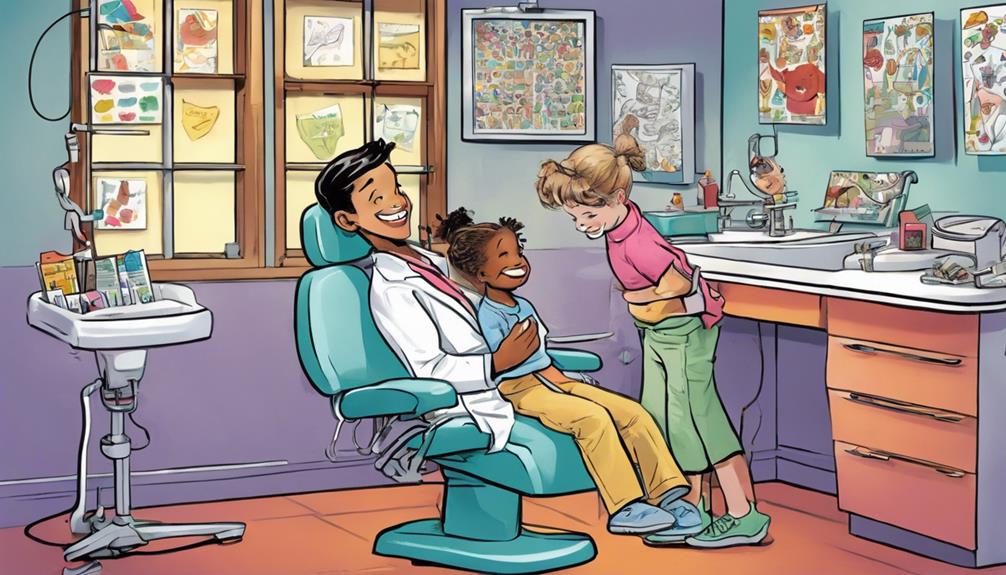
Regular dental visits are essential for establishing healthy habits right from the start.
They help you catch any potential issues early and guarantee your child receives personalized care tailored to their needs.
Establishing Healthy Habits
Starting dental visits by age 1 or with the first tooth plays an important role in setting your child up for a lifetime of healthy habits. Regular check-ups not only monitor oral health but also lay the foundation for establishing a dental care routine. Here's why those early visits are vital:
- Professional Guidance: Pediatric dentists specialize in children's unique oral health needs, providing age-appropriate care.
- Teething Tips: Discussing teething and dietary habits during the first dentist visit can alleviate concerns and promote healthy growth.
- Brushing Techniques: Early visits help teach proper brushing and flossing techniques, fostering good habits from the start.
- Alignment Awareness: Routine check-ups can spot potential alignment issues or cavities before they become significant problems.
As your child's teeth come in, regular dental visits guarantee you're taking proactive steps toward their oral health.
Early Detection of Issues
Early dental visits help catch potential oral health issues before they become serious problems, ensuring your child has the best chance for a healthy smile. Starting these visits by age 1 or when your child's first tooth erupts is essential for early detection of issues like misalignment, cavities, or delays in tooth development. Pediatric dentists specialize in the unique dental needs of infants and toddlers, so they can provide tailored care and advice.
Establishing a routine for dental visits allows you to monitor your child's dental growth and address any concerns promptly. You'll learn about proper oral hygiene practices and dietary habits that can support your child's dental health. By visiting the dentist regularly, you're not just reacting to problems; you're proactively ensuring that your child's teeth come in correctly and healthily.
These visits also serve as an educational opportunity for you as a parent, helping you understand the importance of maintaining good oral hygiene from the very beginning. Remember, catching issues early can lead to more effective treatments and better long-term outcomes for your child's smile.
Personalized Care Strategies
Consistent dental visits are essential for ensuring your child's oral health, as they provide personalized care strategies tailored to their developmental needs. Starting visits by age 1 or when the first baby teeth erupt sets the foundation for healthy teeth and gums.
Here are some key benefits of regular dental check-ups:
- Early Detection: Regular visits help identify potential issues with your child's teeth early, like cavities or alignment problems.
- Preventive Care: Pediatric dentists focus on preventive measures, ensuring your child's teeth will begin to develop healthily.
- Guidance on Hygiene: Your dentist can offer personalized care strategies to establish effective oral hygiene routines as your child's teeth emerge.
- Addressing Concerns: If you have questions about teething or the timing of tooth eruption, your dentist is the go-to resource for reassurance and advice.
Baby Teeth Loss Timeline
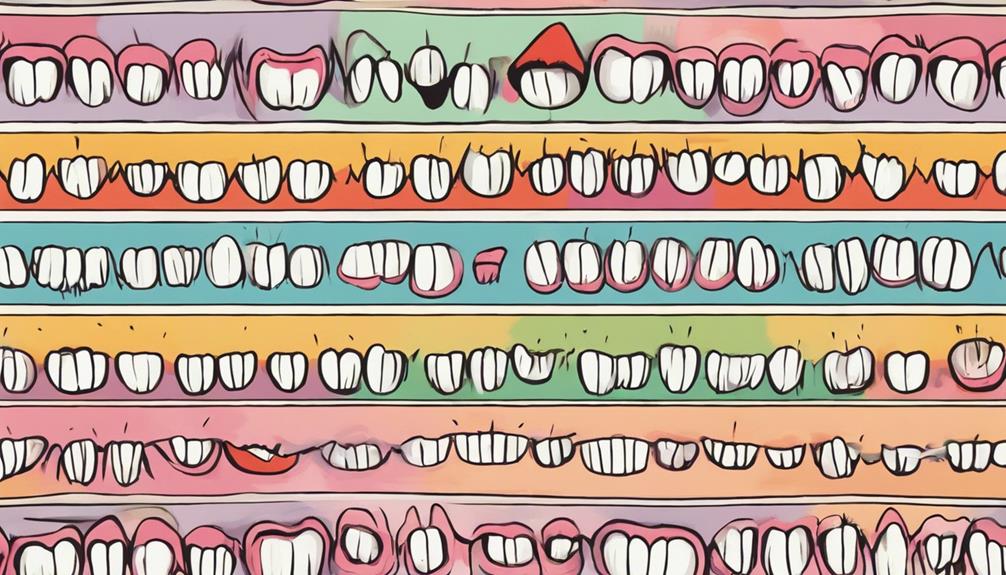
Around ages 6 to 7, you'll notice your child's baby teeth beginning to fall out, beginning with the lower central incisors. This process typically follows the order in which the teeth appeared, so expect the upper central incisors to follow shortly after. It can be an exciting time for both you and your child, as they shift to their permanent adult teeth.
As your child progresses through this phase, canines usually start to loosen between ages 9 to 12. During this period, you might also see molars falling out. By age 13, most children will have lost all their primary baby teeth, resulting in 28 permanent adult teeth.
Keep in mind that this timeline can vary from child to child, but the general sequence remains consistent. Monitoring your child's tooth loss can help you guarantee that everything is progressing normally.
If you have any concerns, don't hesitate to consult your dentist for guidance. This journey of losing baby teeth is a significant milestone in your child's development, marking the shift from childhood to adolescence.
Cultural Practices Around Teething

As your child experiences the loss of baby teeth, many cultures celebrate teething with unique rituals and traditions that highlight this important developmental phase. These cultural practices not only mark the change but also provide support and comfort during this time.
Here are some common teething celebrations and remedies you might encounter:
- Teething Ceremonies: In various cultures, families gather for a special celebration to honor this developmental milestone, often involving storytelling and sharing experiences.
- Herbal Remedies: Many communities use traditional herbal remedies to alleviate teething discomfort, passed down through generations, which may include chamomile or clove oil.
- Rites of Passage: Some cultures view teething as a rite of passage, believing it symbolizes growth and maturity in the child's life.
- Community Support: Engaging with friends and family during this time creates a sense of belonging and reassurance, helping parents navigate the challenges of teething.
Maintaining Oral Health for Infants

Maintaining your infant's oral health is essential from the moment their first tooth appears, ensuring they develop healthy dental habits early on. When babies start teething, it's important to begin a routine for oral hygiene.
Use a soft cloth or a small, soft-bristled toothbrush with water to gently clean your infant's gums and emerging baby teeth, even before they've fully erupted. This practice not only keeps their mouths clean but also helps them get used to having their teeth brushed.
You can introduce fluoride toothpaste around age 2, when your child can spit, to help strengthen their teeth and prevent cavities. Regular dental check-ups should begin by age 1 or with the appearance of the first tooth, allowing for the early identification of any potential dental issues.
Be cautious about what your baby consumes, especially before bedtime. Avoid sending them to bed with milk or juice, as prolonged exposure to sugary liquids can lead to tooth decay.
Frequently Asked Questions
In What Order Do Babies' Teeth Come Through?
When you're curious about the order babies' teeth come in, you'll notice they typically start with the lower central incisors. Next, the upper central incisors emerge, followed by other teeth in a specific sequence. This sequence is often referred to as the “baby teething timeline.” After the central incisors, the lateral incisors will usually appear, followed by the first molars and then the canines. This pattern of tooth eruption can vary slightly from one child to another, but it generally follows this order. Understanding the baby teething timeline can help parents anticipate when to expect new teeth to come in and provide proper care and relief for their little ones during this developmental stage. It’s important to note that every child is unique, so variations in the baby teeth eruption timeline may occur. Some babies may get their teeth earlier or later than the typical sequence, and that’s perfectly normal. Additionally, it’s crucial for parents to maintain good oral hygiene for their infants by gently cleaning their gums and emerging teeth. Regular dental check-ups can also help monitor the progress of the baby teething timeline and ensure that everything is developing as it should.
Does It Matter if Baby Teeth Come in Out of Order?
It doesn't really matter if your child's baby teeth come in out of order. As long as all 20 teeth appear by age 3, and they're healthy, the sequence isn't a major concern.
When Do Babies' Teeth Come in a Chart?
Did you know that most babies have a full set of 20 primary teeth by age 3? You can find charts showing when each tooth typically erupts, starting around 6 months for those first teeth.
What Order Does a Baby Tooth Erupt?
When a baby's teeth erupt, you'll notice they usually come in a specific order. You'll see lower central incisors first, followed by upper central incisors, then lateral incisors, molars, and finally canines.
Conclusion
In the journey of your baby's teething, remember that each tooth's emergence is like a tiny milestone on the path to a healthy smile.
Staying attentive to the signs and symptoms will help you soothe their discomfort.
Don't forget the importance of regular dental visits to guarantee their little teeth develop properly.
By nurturing their oral health from the start, you're setting the foundation for a lifetime of bright smiles and healthy habits.
